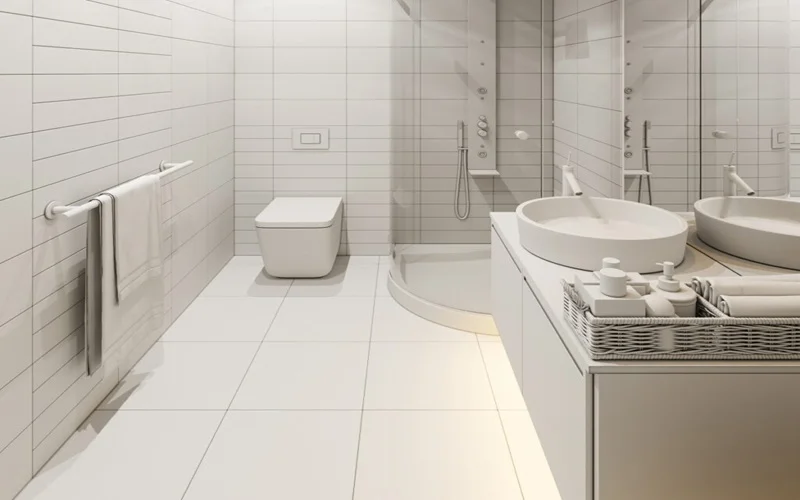Bathroom and toilet tiles

The use of ceramic and tiles in bathroom and toilet interior design, as one of the most important elements of decoration, has a great impact on the beauty and functionality of these spaces. In this article, we will examine the features and benefits of using ceramic tiles on the floors and walls of these places.
Ceramic tiles on the bathroom floor
Features:
Ceramic tiles are chosen for bathroom floors because of their high resistance to moisture and abrasion. These materials are easy to clean and prevent water penetration.
- Moisture resistance: Ceramic and porcelain tiles are specifically designed for wet spaces, making them a good choice for bathroom floors.
- Durability and Longevity: These types of tiles do not easily scratch or damage and can last for years without needing to be replaced.
Advantages:
- Slip resistance: Some tiles have a non-slip surface that provides added safety. This is especially important in bathrooms where there is a risk of slipping.

- Variety of designs and colors: Floor tiles are available in a variety of designs and colors that allow for beautiful decorations. Choosing light colors can create a larger and brighter space.
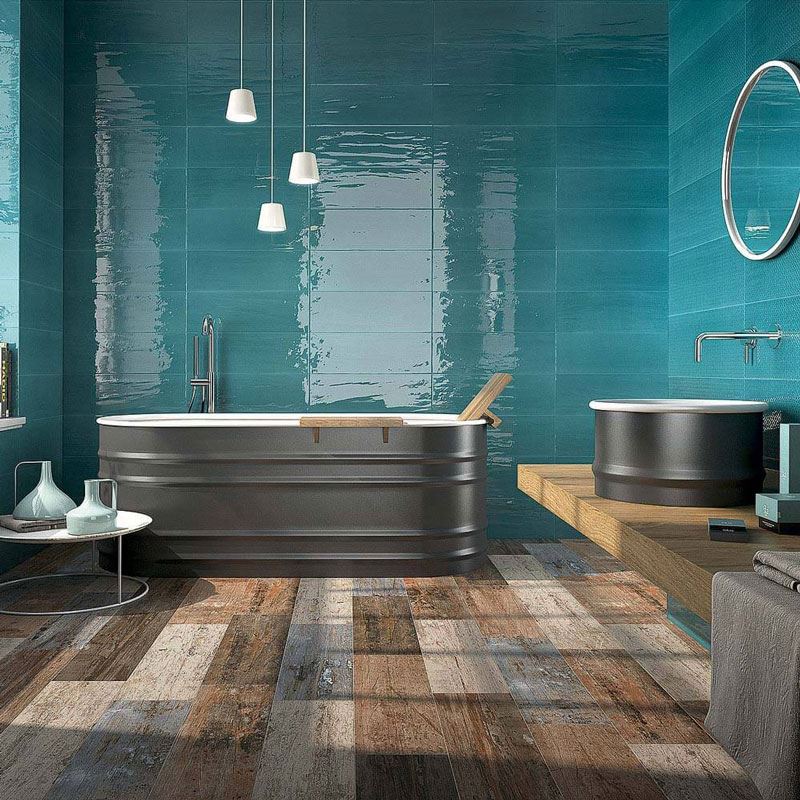
Ceramic tiles on the bathroom wall
Features:
Ceramic tiles for bathroom walls not only add to the beauty of the space, but also act as a protective layer against moisture.
- Moisture resistance: These materials prevent water from penetrating the walls and increase the useful life of the building. Using tiles on the walls helps prevent damage caused by moisture.
- Soundproofing: Some types of tiles can act as soundproofing and prevent sound from transmitting to other spaces.
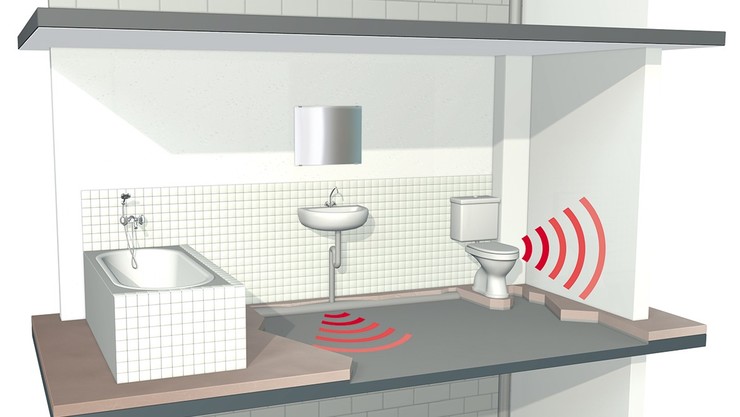
Advantages:
- Easy to clean: The smooth surface of tiles and ceramics allows for easy removal of dirt and stains. This feature makes bathroom and toilet maintenance easier.
- Creating a sense of larger space: By using large tiles and appropriate designs, you can create a sense of larger space in the bathroom.
Important points when choosing ceramic tiles
1- Choosing the type of tile:
The choice between ceramic and porcelain tile depends on personal needs and taste.
- Ceramic: Usually comes at a more affordable price and is suitable for spaces with moderate humidity.
- Porcelain tile: Due to its greater compactness, it has higher resistance to moisture and abrasion and is very suitable for wet spaces such as bathrooms and toilets.
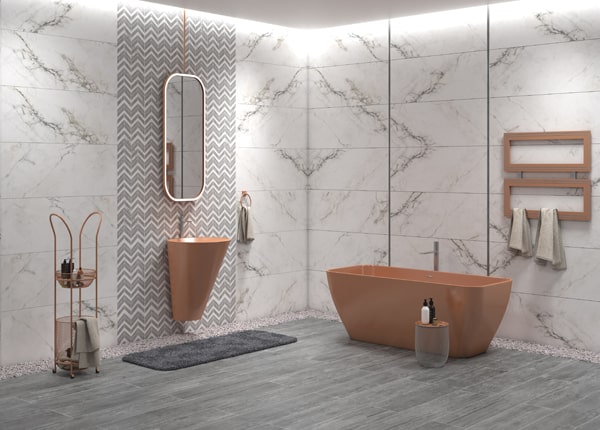
2- Pay attention to size and design:
Choosing the size and design of tiles can have a huge impact on the dimensions and feel of a space.
- Larger tiles: These types of tiles can make a smaller space appear larger and require fewer joints, making them easier to maintain.
- Small tiles: These types of tiles allow you to create more complex patterns and give a more creative feel to the space.
3- Check the price:
The price of ceramic tiles varies depending on the type and quality.
- Price Comparison: It is recommended to check prices and compare options before purchasing. Also, paying attention to the quality and durability of the tiles can help save money in the long run.
Maintenance and repair of tiles in bathrooms and toilets

Maintaining and repairing tiles in bathrooms and toilets is of utmost importance. By following the tips below, you can extend the life of the tiles and maintain the beauty of the space.
Regular cleaning
Regular cleaning of tiles helps prevent the accumulation of dirt and grime. This can be done using a mild detergent and warm water.
Cleaning methods:
- Use vinegar: Natural vinegar acts as an excellent cleaner to remove stains and grime.
- Baking soda solution: Baking soda mixed with water can be used as a paste to remove tough stains.
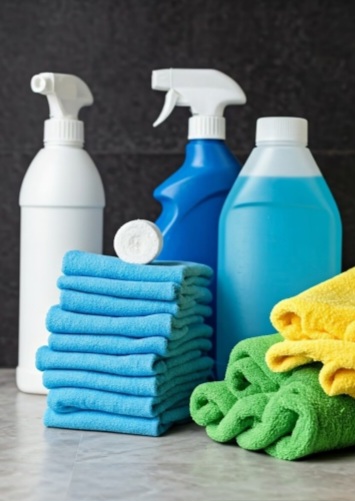
Check for leaks
Leaks can cause damage to the tiles and their substructure over time. Grout layers and joints should be checked regularly. If any leaks are observed, appropriate action should be taken.
Grout repair
Grouts act as insulation between tiles. If the grout is cracked or worn, it should be repaired quickly.
Grout repair steps:
- Cleaning the old grout: Using special tools, the old grout must be carefully removed.
- Filling in new grout: New grout should be carefully placed in the empty spaces and smoothed using the appropriate tool.
Prevents the growth of fungus and mold
The growth of fungus and mold in bathrooms and toilets can damage the beauty and health of the space.
Solutions:
- Proper ventilation: Using fans and leaving windows open helps reduce humidity.
- Use an antifungal: Detergents that have antifungal properties can help prevent their growth.
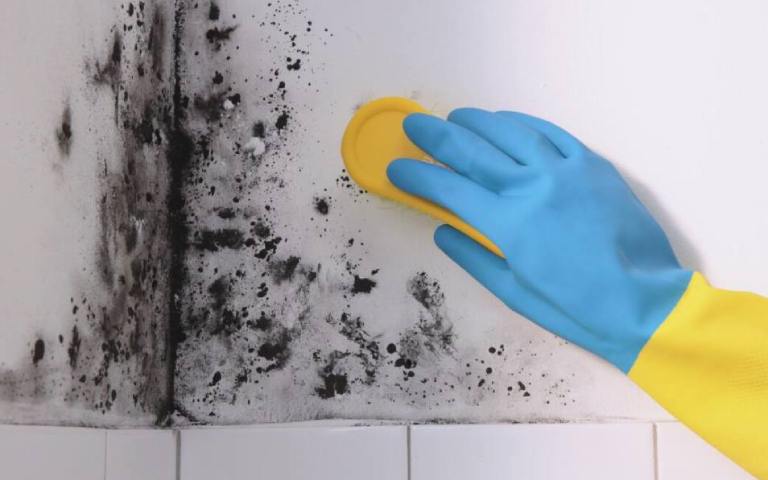
Replacing damaged tiles
If the tiles are broken or cracked, they should be replaced immediately.
Steps for replacing tiles:
- Removing the damaged tile: Using a hammer and appropriate tools, the tile must be carefully removed.
- Cleaning the subsurface: The subsurface must be well cleaned and ready for the installation of new tiles.
- Installing new tiles: New tiles must be installed using special adhesive and then grouted.
Tile adhesive suitable for bathrooms and toilets
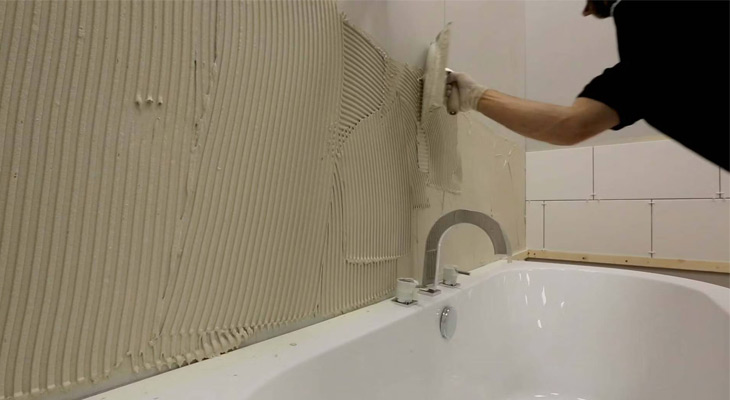
Comparison of powder and paste tile adhesive: The right choice for humid environments.
When choosing a tile adhesive, the type of adhesive and its characteristics can have a great impact on the quality of installation and durability of the tiles. In this article, we will review and compare powder and paste tile adhesives and introduce the most suitable options for wet environments such as bathrooms and toilets.
Powdered tile adhesive
Features:
- Ingredients: Powder adhesives are usually composed of cement, polymeric materials, and other additives.
- Strength: This type of glue has high strength and, after drying, has great resistance to moisture and pressure.
Types:
- Porcelain powder adhesive: Suitable for installing porcelain and heavy tiles.
- Simple powder adhesive: suitable for lighter and ceramic tiles.
Advantages:
- Moisture resistance: Due to special compounds, these adhesives perform better in humid environments.
- Adjustable: It is possible to adjust the thickness of the adhesive layer, which is suitable for installing different tiles.
Disadvantages:
- Preparation time: Requires time for mixing and preparation.
- Difficulty in working with it: It may be difficult for less experienced users to work with it.
Paste tile adhesive
Features:
- Ingredients: Paste adhesives usually contain polymer resins and other additives.
- Easy to use: This type of glue is ready to use and does not require mixing.
Types:
- Porcelain paste adhesive: Suitable for installing porcelain tiles.
- Simple paste adhesive: suitable for ceramic and light tiles.
Advantages:
- Ease of use: It can be used easily and without the need for special expertise.
- Good adhesion: Under normal conditions, it has good adhesion.
Disadvantages:
- Less moisture resistance: Compared to powder adhesives, it may perform less well in humid environments such as bathrooms and washrooms.
- Limitations on tile type: It is most suitable for light and ceramic tiles and is not recommended for heavier tiles.
Which adhesive is best for humid environments?
- For wet environments such as bathrooms and kitchens, powder tile adhesive is a better option due to its higher resistance to moisture and greater strength. This adhesive is especially recommended for installing porcelain and heavy tiles.
- On the other hand, paste tile adhesive can be suitable for installing simple ceramic tiles due to its ease of use and convenient application, but it is less effective in wet conditions.
- Considering these points, the choice of adhesive type depends on the type of tile and environmental conditions, and it is recommended to use powder adhesive for humid environments.
Ideas for designing and arranging tiles in the bathroom and toilet
The design and arrangement of tiles in the bathroom and toilet not only contributes to the beauty of the space, but also affects its function and efficiency.
Use of geometric patterns
Description
Using geometric patterns in your tile layout can add depth and interest to a space. These patterns can include square, rectangular, or triangular shapes.
Benefits
- Create a sense of movement: Geometric patterns can add a sense of movement and dynamism to a space.
- Visual variety: This design creates visual variety and prevents monotony.
Contrasting color combinations
Description
Combining contrasting colors in tiles can have a huge impact on the visual appeal of a bathroom. Using dark and light colors alternately can give a space a special look.
Benefits
- Attention-grabbing: Contrasting colors can draw attention to specific points in a space.
- Creating balance: This combination can help create balance and harmony in the design.

Using large tiles

Description
Large tiles can create a larger, more open feel by reducing the number of seams. This type of tile is especially effective in small bathrooms.
Benefits
- Reduced maintenance requirements: By reducing seams, the need for cleaning and maintenance is reduced.
- Creating a sense of luxury: Large tiles usually convey a sense of luxury and modernity.
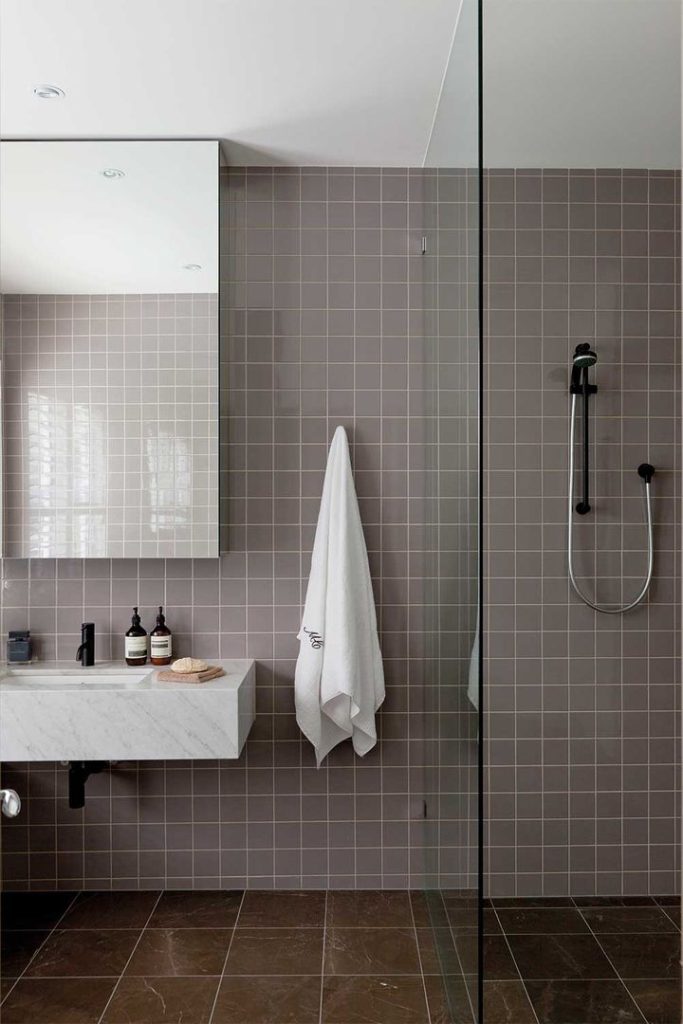
Vertical arrangement of tiles
Description
Arranging tiles vertically can help increase the visual height of a space. This method can be especially effective in small bathrooms.
Benefits
- Increase visual height: This arrangement can make the space feel taller and more spacious.
- Visual appeal: Vertical layout can add a special appeal to walls.
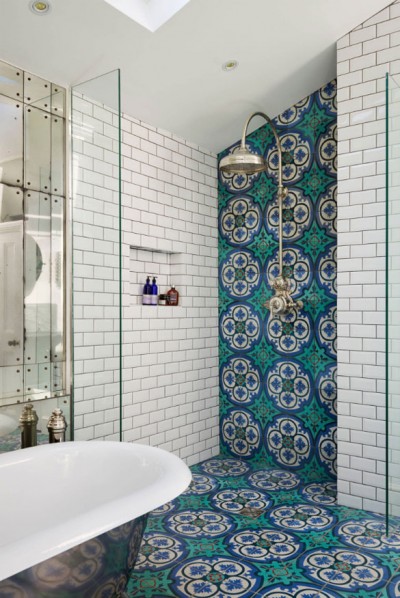
Using patterned tiles
Description
Patterned tiles can act as a focal point in a bathroom or washroom design. These tiles can be used alone or in combination with plain tiles.
Benefits
- Attention-grabbing: Patterned tiles can act as a focal point in a space.
- Variety in design: These tiles add more variety and appeal to the design of the space.
Conclusion
Using ceramic tiles in bathroom and toilet interior design not only adds to the beauty of these spaces, but also improves their functionality. Choosing the right type of adhesive is very important, especially in humid environments.
Powder adhesives are ideal for installing porcelain and heavy-duty tiles due to their higher moisture resistance and greater strength. Paste adhesives, on the other hand, are more suitable for ceramic tiles due to their ease of use, but may be less effective in wet conditions.
Considering these points, choosing the right tile, ceramic, and adhesive can help increase the durability and beauty of your bathroom and toilet space.

